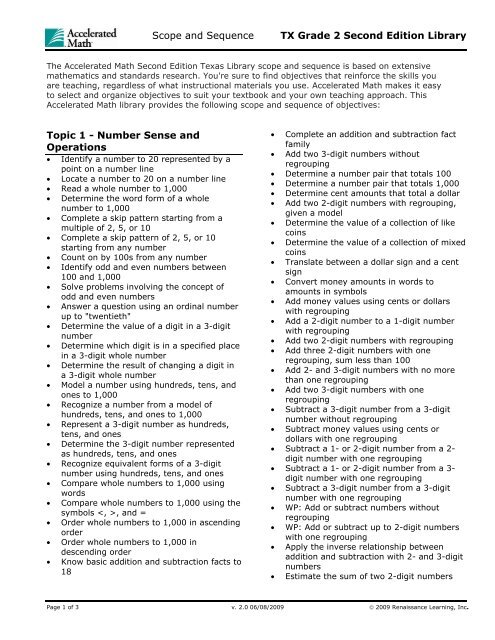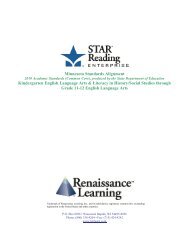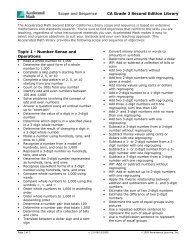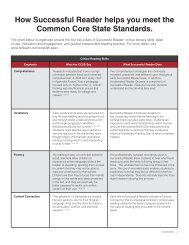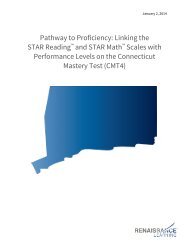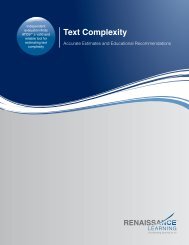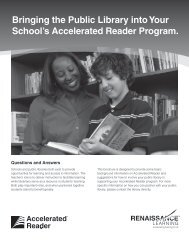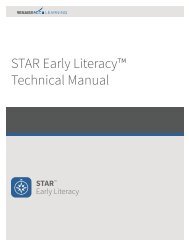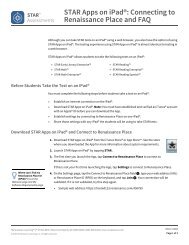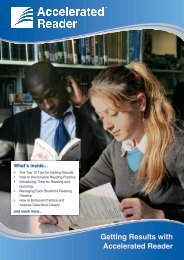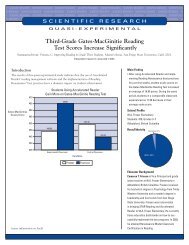Grade 2 - Renaissance Learning
Grade 2 - Renaissance Learning
Grade 2 - Renaissance Learning
Create successful ePaper yourself
Turn your PDF publications into a flip-book with our unique Google optimized e-Paper software.
Scope and SequenceTX <strong>Grade</strong> 2 Second Edition LibraryThe Accelerated Math Second Edition Texas Library scope and sequence is based on extensivemathematics and standards research. You're sure to find objectives that reinforce the skills youare teaching, regardless of what instructional materials you use. Accelerated Math makes it easyto select and organize objectives to suit your textbook and your own teaching approach. ThisAccelerated Math library provides the following scope and sequence of objectives:Topic 1 - Number Sense andOperations• Identify a number to 20 represented by apoint on a number line• Locate a number to 20 on a number line• Read a whole number to 1,000• Determine the word form of a wholenumber to 1,000• Complete a skip pattern starting from amultiple of 2, 5, or 10• Complete a skip pattern of 2, 5, or 10starting from any number• Count on by 100s from any number• Identify odd and even numbers between100 and 1,000• Solve problems involving the concept ofodd and even numbers• Answer a question using an ordinal numberup to "twentieth"• Determine the value of a digit in a 3-digitnumber• Determine which digit is in a specified placein a 3-digit whole number• Determine the result of changing a digit ina 3-digit whole number• Model a number using hundreds, tens, andones to 1,000• Recognize a number from a model ofhundreds, tens, and ones to 1,000• Represent a 3-digit number as hundreds,tens, and ones• Determine the 3-digit number representedas hundreds, tens, and ones• Recognize equivalent forms of a 3-digitnumber using hundreds, tens, and ones• Compare whole numbers to 1,000 usingwords• Compare whole numbers to 1,000 using thesymbols , and =• Order whole numbers to 1,000 in ascendingorder• Order whole numbers to 1,000 indescending order• Know basic addition and subtraction facts to18• Complete an addition and subtraction factfamily• Add two 3-digit numbers withoutregrouping• Determine a number pair that totals 100• Determine a number pair that totals 1,000• Determine cent amounts that total a dollar• Add two 2-digit numbers with regrouping,given a model• Determine the value of a collection of likecoins• Determine the value of a collection of mixedcoins• Translate between a dollar sign and a centsign• Convert money amounts in words toamounts in symbols• Add money values using cents or dollarswith regrouping• Add a 2-digit number to a 1-digit numberwith regrouping• Add two 2-digit numbers with regrouping• Add three 2-digit numbers with oneregrouping, sum less than 100• Add 2- and 3-digit numbers with no morethan one regrouping• Add two 3-digit numbers with oneregrouping• Subtract a 3-digit number from a 3-digitnumber without regrouping• Subtract money values using cents ordollars with one regrouping• Subtract a 1- or 2-digit number from a 2-digit number with one regrouping• Subtract a 1- or 2-digit number from a 3-digit number with one regrouping• Subtract a 3-digit number from a 3-digitnumber with one regrouping• WP: Add or subtract numbers withoutregrouping• WP: Add or subtract up to 2-digit numberswith one regrouping• Apply the inverse relationship betweenaddition and subtraction with 2- and 3-digitnumbers• Estimate the sum of two 2-digit numbersPage 1 of 3 v. 2.0 06/08/2009 © 2009 <strong>Renaissance</strong> <strong>Learning</strong>, Inc.
Scope and Sequence• Estimate the difference of two 2-digitnumbers• Determine the sum of equal groups usingpictures• Use a repeated addition sentence torepresent the sum of equal groups• Use a multiplication sentence to representthe sum of equal groups• Represent repeated addition asmultiplication• Know multiplication tables for 2, 5, and 10• WP: Multiply a 1-digit number by 2, 5, or10• Recognize the number of equal groupsusing pictures• Divide objects into equal groups usingpictures• Determine the remainder when dividingobjects into equal groups• Determine the number of equal groups ofobjects excluding the remainder• WP: Divide objects into equal groups bysharing• Identify a unit fraction as part of a whole• Identify a unit fraction as part of a set ofobjects• Identify a fraction as part of a set of objects• Identify a fraction as part of a whole• Relate a fraction equal to a whole to apictorial model• Determine if a fractional part of a whole iscloser to 0, 1/2, or 1• Compare unit fractions using pictorialmodels• Order unit fractions using pictorial modelsTopic 2 - Algebraic Thinking• Determine a missing addend in a numbersentence involving 2-digit numbers• Determine a missing subtrahend in anumber sentence involving 2-digit numbers• Determine equivalent addition expressionsinvolving 2-digit numbers• WP: Use an open sentence to represent agiven situation• Determine a pattern on a 1 to 100 chart• Complete a pattern on a 1 to 100 chart• Determine an addition or subtractionnumber pattern given a rule• Determine the rule for an addition orsubtraction number patternTX <strong>Grade</strong> 2 Second Edition Library• Extend a number pattern involving addition• Extend a number pattern involvingsubtraction• Extend a pattern given a table of relatednumber pairs• Determine a repeating patterncorresponding to the same patternexpressed using different elementsTopic 3 - Geometry andMeasurement• Measure length in inches• Identify whether an activity takesapproximately 1 second, 1 minute, or 1hour• Tell time to the quarter hour• Tell time to 5-minute intervals• WP: Calculate elapsed time• Read a thermometer in degrees Celsius• Read a thermometer in degrees Fahrenheit• Relate area to the number of square units• Identify figures that are the same size andshape• Relate a polygon to attributes orcharacteristics• Describe how two 2-dimensional geometricfigures are alike or different• Identify a parallelogram, a trapezoid, apentagon, a hexagon, or an octagon• Decompose a plane shape composed ofthree or more simpler shapes• Describe how two 3-dimensional geometricfigures are alike or different• Follow directions on a simple mapTopic 4 - Data Analysis andStatistics• Read a multi-category tally chart• Use a tally chart to represent data• Answer a question using information from atally chart• Read a bar graph with a y-axis scale by 2s• Use a bar graph with a y-axis scale by 2s torepresent data• Answer a question using information from abar graph with a y-axis scale by 2s• Determine which event is less likely ormore likely to occurPage 2 of 3 v. 2.0 06/08/2009 © 2009 <strong>Renaissance</strong> <strong>Learning</strong>, Inc.
Scope and SequenceTX <strong>Grade</strong> 2 Second Edition LibraryAccelerated Math Libraries include analmost unlimited supply of dynamic algorithmgeneratedproblems for both assisted-response(multiple-choice) and free-response assignments.Eleven Texas libraries are available:<strong>Grade</strong> 1 <strong>Grade</strong> 7<strong>Grade</strong> 2 <strong>Grade</strong> 8<strong>Grade</strong> 3 Algebra 1<strong>Grade</strong> 4 Algebra 2<strong>Grade</strong> 5 Geometry<strong>Grade</strong> 6Please call us toll-free at 1-800-338-4204to order this Accelerated Math library or torequest the Scope and Sequence for otherlibraries.Accelerated Math LibraryTX Accelerated Math Second Edition <strong>Grade</strong> 2P.O. Box 8036Wisconsin Rapids, WI 54495-8036(800) 338-4204www.renlearn.comPage 3 of 3 v. 2.0 06/08/2009 © 2009 <strong>Renaissance</strong> <strong>Learning</strong>, Inc.


